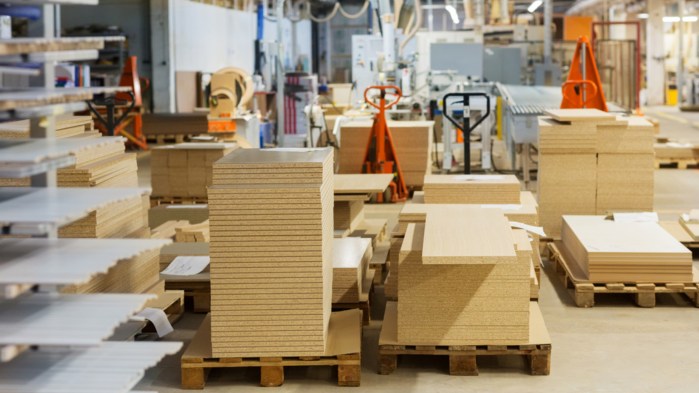The EU MDF Market to Post Moderate But Steady Growth
IndexBox has just published a new report: ‘EU – MDF – Market Analysis, Forecast, Size, Trends and Insights’. Here is a summary of the report’s key findings.
The revenue of the MDF market in the European Union amounted to $5.3B in 2018. This figure reflects the total revenues of producers and importers (excluding logistics costs, retail marketing costs, and retailers’ margins, which will be included in the final consumer price). The market value increased at an average annual rate of +5.5% over the period from 2013 to 2018; the trend pattern remained consistent, with only minor fluctuations in certain years. The pace of growth appeared the most rapid in 2018 when the market value increased by 12% y-o-y. In that year, the market attained its peak level and is likely to continue its growth in the immediate term.
Consumption by Country
Poland (3.3M cubic meters) constituted the country with the largest volume of MDF consumption, accounting for 28% of total volume. Moreover, MDF consumption in Poland exceeded the figures recorded by the second-largest consumer, Italy (1.3M cubic meters), threefold. The third position in this ranking was occupied by the UK (1.3M cubic meters), with a 11% share.
In Poland, MDF consumption expanded at an average annual rate of +6.6% over the period from 2013-2018. In the other countries, the average annual rates were as follows: Italy (+7.5% per year) and the UK (+2.7% per year).
In value terms, the largest MDF markets in the European Union were Poland ($1.3B), Italy ($713M) and the UK ($657M), together accounting for 50% of the total market. France, Spain, Germany, the Netherlands, Romania, Portugal, Austria, Sweden and Hungary lagged somewhat behind, together accounting for a further 39%.
In 2018, the highest levels of MDF per capita consumption was registered in Poland (87 cubic meters per 1000 persons), followed by Portugal (38 cubic meters per 1000 persons), Romania (29 cubic meters per 1000 persons) and Austria (28 cubic meters per 1000 persons), while the world average per capita consumption of MDF was estimated at 23 cubic meters per 1000 persons.
Market Forecast to 2030
Driven by increasing demand for MDF in the European Union, the market is expected to continue an upward consumption trend over the next decade. Market performance is forecast to decelerate, expanding with an anticipated CAGR of +2.4% for the period from 2018 to 2030, which is projected to bring the market volume to 16M cubic meters by the end of 2030.
Production in the EU
The volume of MDF production totaled 13M cubic meters in 2018, remaining constant against the previous year. The total output increased at an average annual rate of +2.7% from 2013 to 2018; the trend pattern remained relatively stable, with only minor fluctuations being recorded throughout the analyzed period. The pace of growth appeared the most rapid in 2015 with an increase of 8.4% y-o-y. The volume of MDF production peaked at 13M cubic meters in 2017, leveling off in the following year.
Production by Country
Poland (3.6M cubic meters) remains the largest MDF producing country in the European Union, accounting for 28% of total volume. Moreover, MDF production in Poland exceeded the figures recorded by the second-largest producer, Spain (1.5M cubic meters), twofold. The third position in this ranking was occupied by Germany (1.5M cubic meters), with a 11% share.
In Poland, MDF production expanded at an average annual rate of +4.8% over the period from 2013-2018. In Spain, the average annual rates stood at +6.3% per year, while in Germany, the volume of production practically mirrored its outset level of 2013.
Exports in the EU
In 2018, the amount of MDF exported in the European Union amounted to 6.5M cubic meters, remaining relatively unchanged against the previous year. Overall, MDF exports, however, continue to indicate a relatively flat trend pattern. The pace of growth appeared the most rapid in 2016 when exports increased by 3.3% y-o-y. In that year, MDF exports attained their peak of 6.7M cubic meters. From 2017 to 2018, the growth of mdf exports failed to regain its momentum. In value terms, MDF exports amounted to $3.3B (IndexBox estimates) in 2018.
Exports by Country
In 2018, Germany (1.5M cubic meters), distantly followed by Belgium (1,012K cubic meters), Poland (682K cubic meters), Spain (643K cubic meters), France (436K cubic meters), Austria (404K cubic meters) and Ireland (322K cubic meters) were the major exporters of MDF , together comprising 77% of total exports. Romania (261K cubic meters), Portugal (259K cubic meters), Italy (218K cubic meters), Hungary (185K cubic meters) and Slovenia (136K cubic meters) followed a long way behind the leaders.
From 2013 to 2018, the most notable rate of growth in terms of exports, amongst the main exporting countries, was attained by France, while exports for the other leaders experienced more modest paces of growth.
In value terms, the largest MDF supplying countries in the European Union were Germany ($854M), Belgium ($565M) and Austria ($317M), with a combined 53% share of total exports. These countries were followed by Spain, Poland, France, Ireland, Italy, Portugal, Romania, Hungary and Slovenia, which together accounted for a further 39%.
Export Prices by Country
The MDF export price in the European Union stood at $503 per cubic meter in 2018, picking up by 7% against the previous year. Over the period under review, the export prices for MDF reached their maximum in 2014; however, from 2015 to 2018, export prices remained at a lower figure.
Prices varied noticeably by the country of origin; the country with the highest price was Austria ($784 per cubic meter), while Romania ($292 per cubic meter) was amongst the lowest.
From 2013 to 2018, the most notable rate of growth in terms of prices was attained by Italy, while the other leaders experienced more modest paces of growth.
Imports in the EU
In 2018, approx. 5.3M cubic meters of MDF were imported in the European Union; going up by 5.3% against the previous year. The total import volume increased at an average annual rate of +5.2% from 2013 to 2018; the trend pattern remained relatively stable, with only minor fluctuations being observed throughout the analyzed period. The growth pace was the most rapid in 2017 with an increase of 8.6% against the previous year. The volume of imports peaked in 2018 and are expected to retain its growth in the immediate term. In value terms, MDF imports stood at $2.6B (IndexBox estimates) in 2018.
Imports by Country
The countries with the highest levels of MDF imports in 2018 were Italy (599K cubic meters), the UK (570K cubic meters), the Netherlands (469K cubic meters), Germany (463K cubic meters), France (433K cubic meters), Poland (411K cubic meters), Belgium (335K cubic meters), Portugal (269K cubic meters), Spain (249K cubic meters), Sweden (212K cubic meters) and Romania (201K cubic meters), together acoounting for 80% of total import.
From 2013 to 2018, the most notable rate of growth in terms of imports, amongst the main importing countries, was attained by Poland, while imports for the other leaders experienced more modest paces of growth.
In value terms, the largest MDF importing markets in the European Union were the UK ($338M), Germany ($269M) and Italy ($255M), with a combined 33% share of total imports. France, the Netherlands, Spain, Poland, Belgium, Sweden, Portugal, Romania and Austria lagged somewhat behind, together accounting for a further 49%.
Import Prices by Country
The MDF import price in the European Union stood at $492 per cubic meter in 2018, rising by 4.9% against the previous year. Over the period under review, the mdf import price, however, continues to indicate a slight curtailment.
Prices varied noticeably by the country of destination; the country with the highest price was the UK ($593 per cubic meter), while Poland ($320 per cubic meter) was amongst the lowest.
From 2013 to 2018, the most notable rate of growth in terms of prices was attained by Spain, while the other leaders experienced more modest paces of growth.
Source: IndexBox AI Platform





Leave a Reply